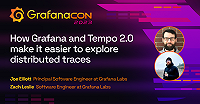Important: This documentation is about an older version. It's relevant only to the release noted, many of the features and functions have been updated or replaced. Please view the current version.
Multi-tenancy
Tempo is a multi-tenant distributed tracing backend. It supports multi-tenancy through the use
of a header: X-Scope-OrgID.
This guide details how to setup multi-tenancy.
If you’re interested in setting up multi-tenancy, consult the multi-tenant example in the repo. This example uses the following settings to achieve multi-tenancy in Tempo.
Configure the OTEL Collector to attach the X-Scope-OrgID header on push:
exporters:
otlp:
headers:
x-scope-orgid: foo-bar-bazGrafana 7.5.x and higher
Configure the Tempo data source in Grafana to pass the tenant with the same header:
- name: Tempo-Multitenant
jsonData:
httpHeaderName1: 'X-Scope-OrgID'
secureJsonData:
httpHeaderValue1: 'foo-bar-baz'Grafana 7.4.x
Grafana 7.4.x has the following configuration requirements:
- Configure the Tempo data source in Grafana to pass the tenant as a bearer token. This is necessary because it is the only header that Jaeger can be configured to pass to its GRPC plugin.
- name: Tempo-Multitenant
jsonData:
httpHeaderName1: 'Authorization'
secureJsonData:
httpHeaderValue1: 'Bearer foo-bar-baz'- Configure Jaeger Query to pass the bearer token to its backend.
--query.bearer-token-propagation=trueImportant notes
Multi-tenancy on ingestion is currently only working with GPRC and this may never change. It is strongly recommended to use the OpenTelemetry Collector to support multi-tenancy as described above.
Enabling multi-tenancy
To enable multi-tenancy on Tempo backend, set the following configuration value on all Tempo components:
multitenancy_enabled: trueor from the command line:
--multitenancy.enabled=trueThis option will force all Tempo components to require the X-Scope-OrgID header.
Was this page helpful?
Related resources from Grafana Labs



